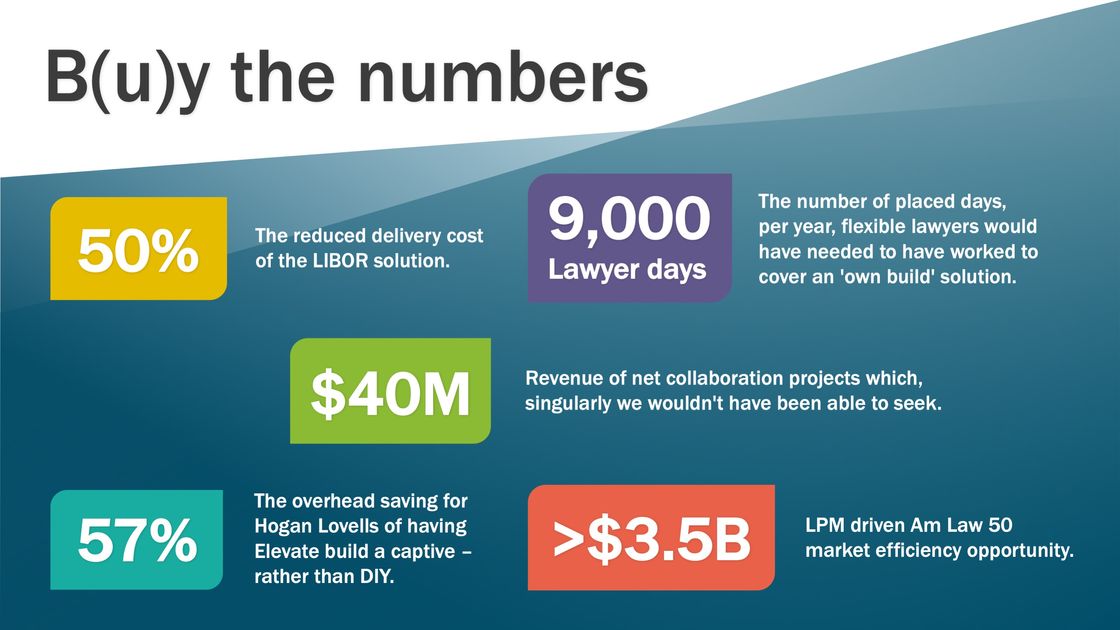The Collaboration Coefficient – by Stephen Allen of Hogan Lovells and Liam Brown of Elevate
February 27, 2020
law company events law department law firm innovation collaboration hogan lovells solidwest
Today we spoke at SOLID West about the rise of successful collaborations between law firms and law companies, defying the conventional wisdom that these entities largely compete.
Legal skills are necessary, but no longer sufficient to solve some of the emerging problems that businesses face, requiring professionals from multiple disciplines to work together. Today the practice of law is interwoven with the business of law and the technology of law.
We are all familiar with the constant pressure that companies are under to innovate new, better products and services to provide greater value to ever-more demanding customers. Law firms are not immune. This continuous innovation, requiring multi-disciplinary expertise and investment, is a lot to ask from a single organization; thus effective law firm/law company collaboration has emerged.
We see three models for collaboration. The first two models are commonplace; the third is rare.
First is the Divergent Model, where the law firm and law company work alongside each other with bright lines on what each will, and will not, do. The parties each ‘stick to their knitting’ and there is no overlap (or even proximity, for that matter) in each organisation’s operations and limited value creation (typically only cost savings) from the collaboration. This scenario is often a ‘forced collaboration’, where a law firm is “encouraged” to collaborate with a law company by a law department, typically unbundling work from the law firm.
The second model is the Independent Model; here, collaboration occurs at a single point of intersection between the parties. This frequently occurs with law firm deployment of legal tech to solve a specific problem. The delivery of a point solution works well to solve one problem, but once delivered, the collaboration ends, failing to continuously drive improved ways of working or delivering value over time.
Finally, there is the Interdependent Model, which is based on individuals from the law firm and the law company trusting one another, no matter where they work. Here, the lines defining each organization’s area of operations overlap. In the very best examples of this, the overlapping line of collaboration is ‘fuzzy’. Fuzzy is good: people work as an integrated team, sharing the strengths of all the individuals to the benefit of both parties. This interdependent collaboration enables the law firm and law company to work together on an on-going basis to devise many different solutions to solve any number of problems–getting better at it, the more they work together.
The results of the collaboration between Hogan Lovells and Elevate have been phenomenal:
- Our collaborative LIBOR Solution enables large-scale regulatory review and repapering; it has proven over 50% more efficient than traditional models
- Had Hogan Lovells built its own flexible resourcing solution rather than partner with Elevate, it would have had to place 9,000 lawyer-days – that’s 72,000 lawyer-hours – to break even
- The net Elevate-Hogan Lovells collaborations have generated $40 million in new revenue
- Collaborating to build a legal delivery center in Phoenix enabled Hogan Lovells to reduce its overhead costs for such an operation by 57%
- Tremendous potential exists: if the AmLaw 50 applied our collaborative approach to legal project management, it would generate more than $3.5 billion in market efficiencies
The numbers speak for themselves and others have noticed. In December, the Financial Times named Hogan Lovells the Most Innovative Law Firm in North America and selected Hogan Lovells’ work with Elevate, FTI Consulting, and Cognia Law for the LIBOR Solution as the Standout Entry in the Collaboration Category.
When we limit our thinking to competition between law firms, law companies, and law departments, we sometimes fall into zero-sum thinking, “for us to win, they have to lose.” When we expand our thinking to include our whole ‘tribe’ of legal innovators getting comfortable with the ‘fuzzy’; as legal professionals–no matter where we work today–then collaboration amplifies our ability to make a difference tomorrow.

Back to Expertise


